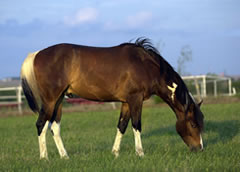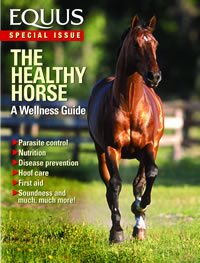
This is the Time of Year we all suffer form pesky Fly infestations in our Barns and pastures. In addition to repellents and other fly-foiling measures, giving your horse access to open, breezy pastures can help keep flies at bay.
Photo by Darrell Dodds
How to Identify, Control Pesky Flies
Do you know what's buzzing by? There are many different types of flies, and a product that controls one might not control another. Here's a who's-who to help you identify--and control--pesky flies.
Fly season is fast approaching, and while you may not see too many flying insects right now, early spring is the time to get a jump on the fly population. In the April 2006 issue of Horse & Rider we took a look at the different types of control methods--from barn spray systems to fly parasites. But knowing which flies you have is an important step in controlling them. Bill Warner, an entomologist and new product development manager for Farnam, offers these tips about some of the flies your horse may (literally) be facing:
Biting Gnats
Black flies (or buffalo gnats) and punkies or no-see-ums are small and often overlooked by horse owners. They can carry parasitic worms, disease organisms and may cause allergic dermatitis.
Use fly repellents containing pyrethrins or pyrethroids, or a combination of the two. Apply to frequently attacked areas, especially the ventral midline (chest and belly) and ears.
Drain marshy areas and make banks of stock tanks and ponds steep to reduce breeding areas.
Allow horses access to more exposed breezy areas.
Eye Gnats
Adult Chloropid gnats are non-biting flies but they feed on secretions around a horse's eyes and nose, and have been implicated in the transmission of pink eye, yaws and other diseases.
Good sanitation (see article in Horse & Rider, April 2006) can help reduce breeding sites.
Use repellent wipes, sprays and roll-ons on the horse's face.
Some fly baits can help, but aren't effective as the sole control technique.
Horse and Deer Flies
Horse flies (those big, nasty biting flies up to 1 1/4-inch long) and deer flies (smaller, with black bands across their wings) cause painful bites that can make your horse (and you) miserable.
Pasture horses in breezy, open (non-wooded) areas.
Use fly repellents and wipes.
Drain wet, low-lying areas to reduce breeding areas.
Some fly traps--like Farnam's Epps Biting Fly Trap (farnam.com), or Horse Pal (from Newman Enterprises; bitingflies.com)--are effective.
Horn FlyThese blood-sucking flies are generally only a problem if your horses are pastured near infested cattle.
Use fly repellents, insecticidal sprays and wipe-ons.
Stable FlyIf you hear a lot of stomping, you've got stable flies. This common, blood-feeding fly usually feeds on the lower legs (especially forelegs), and horses will stomp their feet in reaction to painful bites. (Foundered or lame horses that can't stomp are especially vulnerable).
Use feedthroughs, fly parasites, repellents, spray systems and sticky traps.
Remove or compost old bedding, manure and wet hay.
Face FlyOccasionally a problem where horses are stabled near cattle, face flies feed on secretions around the face.
Locate horses far away from pastured cattle.
Use fly masks or repellents.
House Fly
The most common fly pest, house flies love horse manure and the mucous secretions and wounds on horses.
Barn spray systems, traps, feedthroughs, fly parasites, repellents and masts/sheets are all effective.
See the April 2006 issue of Horse & Rider for sanitation and control tips.
Bot Fly
Horse bot flies lay eggs on a horse's coat or skin. When a horse licks his legs, he ingests the eggs, which mature into larvae in the horse's stomach lining.
Treat horses with ivermectins or organophosphates labeled for bot control.
Some feedthroughs (specifically tetrachlorvinphos) can control larval bots.
Apply fly repellents.
Use a bot block, bot knife or even your fingernail to remove the eggs.
Chuck & Shirley Bartok
EQUINE-FUN BLOG
Please leave your Comments.

